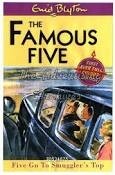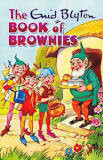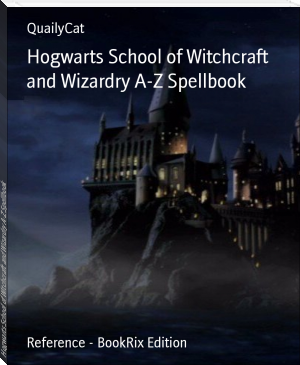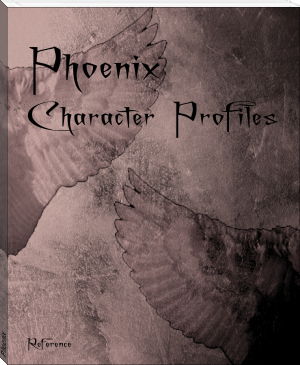Enid Blyton Book by Ayesha Azhar (free ebooks for android .TXT) 📖

- Author: Ayesha Azhar
Book online «Enid Blyton Book by Ayesha Azhar (free ebooks for android .TXT) 📖». Author Ayesha Azhar
Enid Mary Blyton (11 August 1897 – 28 November 1968) was an English children's writer whose books have been among the world's bestsellers for children since the 1930s, selling more than 600 million copies. Blyton's books, covering a broad range of genres from fantasy and mystery stories to natural history, are still enormously popular, and have been translated into almost 90 languages. Best remembered today for her Noddy character, The Famous Five and The Secret Seven series, her first book –Child Whispers a 24-page collection of poems – was published in 1922.

Enid Blyton was born on 11 August 1897 in East Dulwich, London, England, the eldest of three children, to Thomas Carey Blyton (1870–1920), a cutlery salesman, and his wife Theresa Mary Harrison Blyton (1874–1950).From 1907 to 1915 Enid attended St Christopher's School in Beckenham, where she enjoyed physical activities and became school tennis champion and captain of lacrosse. She was not so keen on all the academic subjects but excelled in writing, and in 1911 entered Arthur Mee's children's poetry competition; Mee offered to print her verses, encouraging her to produce more Her mother disapproved of her writing, considering her efforts a "waste of time and money", but she received much encouragement from the aunt of school friend, Mabel Attenborough.After finishing school in 1915 as head girl, Blyton moved out of the family home to live with her friend Mary Attenborough. She then left Beckenham and stayed with George and Emily Hart at Seckford Hal; in Woodbridgen Suffolk, a house whose haunted room and secret passageway reportedly inspired her.
In March in 1916 her first poems were published in Nash's Magazine. Blyton had been rejected by publishers on many occasions, which made her more determined to succeed, remarking that "it is partly the struggle that helps you so much, that gives you determination, character, self-reliance – all things that help in any profession or trade, and most certainly in writing.
In 1920 Blyton moved to Chessington and began writing in her spare time. The following year she won the Saturday Westminster Review writing competition after submitting On the Popular Fallacy that to the Pure All Things are Pure. Reputable publications such as The Londoner, Home Weekly and The Bystanderbegan to show an interest in her short stories and poems.
Blyton's first book, Child Whispers, a 24-page collection of poems, was published in 1922. That year she began writing in annuals for Cassell and George Newnes, and her first piece of writing was accepted for publication in Teachers' World, "Peronei and his Pot of Glue". Her success was boosted in 1923 when her poems were published alongside those of Rudyyard kipling,Walter De La Mare and G.k.Chesterton in a special issue of Teachers' World.
In 1923 Blyton published Real Fairies: Poems and Responsive Singing Games. They were followed by The Enid Blyton Book of Fairies, Songs of Gladness and Sports and Games in 1924, and the Book Of Brownies in 1926 Blyton established a reputation as a children's writer when she began writing for the magazine Sunny Stories which typically included the re-telling of legends, myths and stories and other articles for children.
In the 1930s Blyton developed an interest in writing stories related to various myths, including those of ancient Greece and Rome The Knights of the Round Table, Tales of Ancient Greece and Tales of Robin Hood were published in 1930. In Tales of Ancient GreeceBlyton retold sixteen well-known ancient Greek myths, but used the Latin rather than the Greek names of deities and invented conversations between the characters. The Adventures of Odysseus, Tales of the Ancient Greeks and Persians and Tales of the Romans followed in 1934.
In 1935 Blyton published Birds at Home as part of her Old Thatch Series and The Children's Garden. She released The Green Goblin Book, later republished in abridged form as Feefo, Tuppeny and Jinks, after the characters which appear in the book, by Staples Press in October 1951, and Tuppeny Feefo and Jinks by William Collins in May 1967. Blyton's Hedgerow Tales was illustrated by Vere Temple. The following year she published The Famous Jimmy, illustrated by Benjamin Rabier and The Yellow Fairy Book, illustrated by H.R. Millar. The Yellow Fairy Book displays some similarities with the Enid Blyton Book of Brownies in that it features a search for a missing Princess, but features a gnome as the archenemy.

On 28th August 1924 Enid Blyton married Hugh Alexander Pollock, who was editor of the book department for the publishing firm George Newnes. The two of them had met when Enid was commissioned by Newnes to write a children's book about London Zoo—The Zoo Book (1924.) Hugh had been born and brought up in Ayr and had joined the Royal Scots Fusiliers at the beginning of the First World War, being awarded the D.S.O. (Distinguished Service Order) in 1919. His first marriage had ended when his wife had an affair, and he had to obtain a divorce in order to marry Enid.
The wedding, at Bromley Register Office, was a quiet occasion, with no member of either Enid's or Hugh's family attending the ceremony. The couple honeymooned in Jersey and Enid was later to base Kirrin in the Famous Five books on an island, castle and village they visited there. After the wedding Enid and Hugh lived first of all in an apartment in Chelsea, moving to their first house, newly-built Elfin Cottage in Beckenham, in 1926.
Hugh and Enid led a quiet and contented life in the early years of their marriage, their leisure time consisting of gardening, occasional outings to the theatre and cinema, and seaside holidays. Hugh indulged his wife's playful, childlike side and they would build snowmen together, play "catch" and French cricket in the garden, and have games of "conkers."
At Old Thatch Hugh and Enid began to have more of a social life, enjoying dinner parties, tennis and bridge. In October 1930 they went on a cruise to Madeira and the Canary Islands aboard the Stella Polaris, the details of which remained vividly in Enid's mind, providing her with material for books written years later such as The Pole Star Family and The Ship of Adventure, both published in 1950.
Enid and Hugh had trouble starting a family but eventually, on 15th July 1931, their elder daughter Gillian was born. After a miscarriage in 1934 they went on to have another daughter, Imogen, who was born on 27th October 1935.She did not have a lot of time to spend with her children. She played with the girls for an hour after tea and sometimes took Imogen out with her to meet Gillian from school. Enid and Hugh no longer had as much time together either. Both were very busy with their work.
Enid continued writing during the war years. Hugh rejoined his old regiment—the Royal Scots Fusiliers—and was soon posted to Dorking in Surrey to train Home Guard officers. His absence put even more strain on the already fragile marriage and, while on holiday with Dorothy in Devon in the spring of 1941, Enid Blyton met the man who was to become her second husband, surgeon Kenneth Fraser Darrell Waters. Hugh had also become romantically involved with novelist Ida Crowe, and he and Enid were divorced in 1942. Kenneth divorced his wife too, with whom he had had no children.
Kenneth and Enid were married at the City of Westminster Register Office on 20th October 1943, six days before Hugh's wedding to Ida. Gillian and Imogen had not seen their father since June 1942, when he had left for America to advise on Civil Defence, and sadly they were never to see him again. Although she had promised that Hugh would be free to see his daughters after the divorce, Enid went back on her word and refused to allow him any access at all. She cut her first husband out of her life just as she had done with her mother, perhaps pretending to herself that neither had ever existed. In doing this she was continuing the pattern of behaviour—pretence and denial—that she had learnt in childhood, and making a fiction of her own life. Her autobiography, The Story of My Life (1952), contains photographs of her "happy little family"—herself, her second husband Kenneth, Gillian and Imogen. There is no mention of Hugh and, although it is not explicitly stated, readers are given the impression that Kenneth is the girls' father.
Kenneth, a surgeon, worked at St. Stephen's Hospital in Chelsea, London. He was an active man who enjoyed gardening, tennis and golf. While he was serving in the Navy in the First World War, his ship had been torpedoed at the Battle of Jutland, permanently damaging his hearing. As a result, Kenneth found social situations awkward. His deafness made communication difficult, causing him to come across as rude or insensitive at times.
Kenneth and Enid travelled abroad together only once, in 1948, when they joined friends for a three week semi-business holiday in New York, sailing out on the Queen Elizabeth and back on the Queen Mary. Again, Enid Blyton was to use this experience in a book—The Queen Elizabeth Family, published in 1951. Otherwise, most of their holidays were spent in Dorset where they purchased a golf course and a farm in the 1950s. The farm in Five on Finniston Farm (1960) was inspired by Enid and Kenneth's own farm, Manor Farm in Stourton Caundle, while Five Have a Mystery to Solve (1962) is set firmly in a part of Dorset which Enid Blyton loved, with Whispering Island being based on Brownsea Island in Poole Harbour.
In 1967,her second huband Kenneth died.
AcheivementsEnid Blyton ceased writing her regular column for Teacher's World in 1945, after almost twenty-three years, giving her the opportunity to widen the range of her writing activities. Daughters Gillian and Imogen were both at boarding-school and she had begun most of her major series by then including the Secret series, the Famous Five books, the Find-Outers mysteries, the Adventure series, the St. Clare's books, the Cherry Tree/Willow Farm series and the Faraway Tree and Wishing Chair books. These were later to be joined by the Secret Seven books, the Barney (or "R") mysteries, the Malory Towers series and the Six Cousins books. Noddy made his first appearance in 1949 and by the mid-fifties there was a huge amount of Noddy-themed merchandise in the shops.
Altogether, Enid Blyton is believed to have written around 700 books (including collections of short stories) as well as magazines, articles and poems. She wrote an incredible variety of books for children aged about two to fourteen—adventure and mystery stories, school stories, circus and farm books, fantasy tales, fairy-tales, family stories, nursery stories, nature books, religious books, animal stories, poetry, plays and songs, as well as re-telling myths, legends





Comments (0)